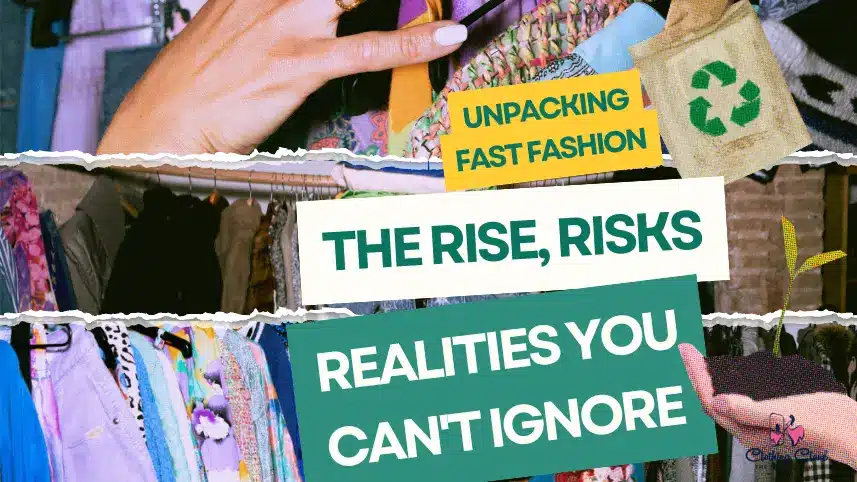Today we will learn What is fast fashion? It’s more than just a buzzword; it’s a game-changer in the fashion industry.
In the fashion world, trends come and go like blinks of an eye. But fast fashion has made a mark that will last. Fast fashion is the mass production of cheap clothes that look like the latest high-end trends.
It has changed how we buy clothes and how we think about style. This movement has changed the fashion industry by making clothes faster, cheaper, and more in line with current trends.
But now that we’re in 2024, it’s hard to ignore the effects of fast fashion.
According to Uniformmarket, As of 2024, the fast fashion industry is worth $136.19 billion and is expected to reach $291.1 billion by 2032.
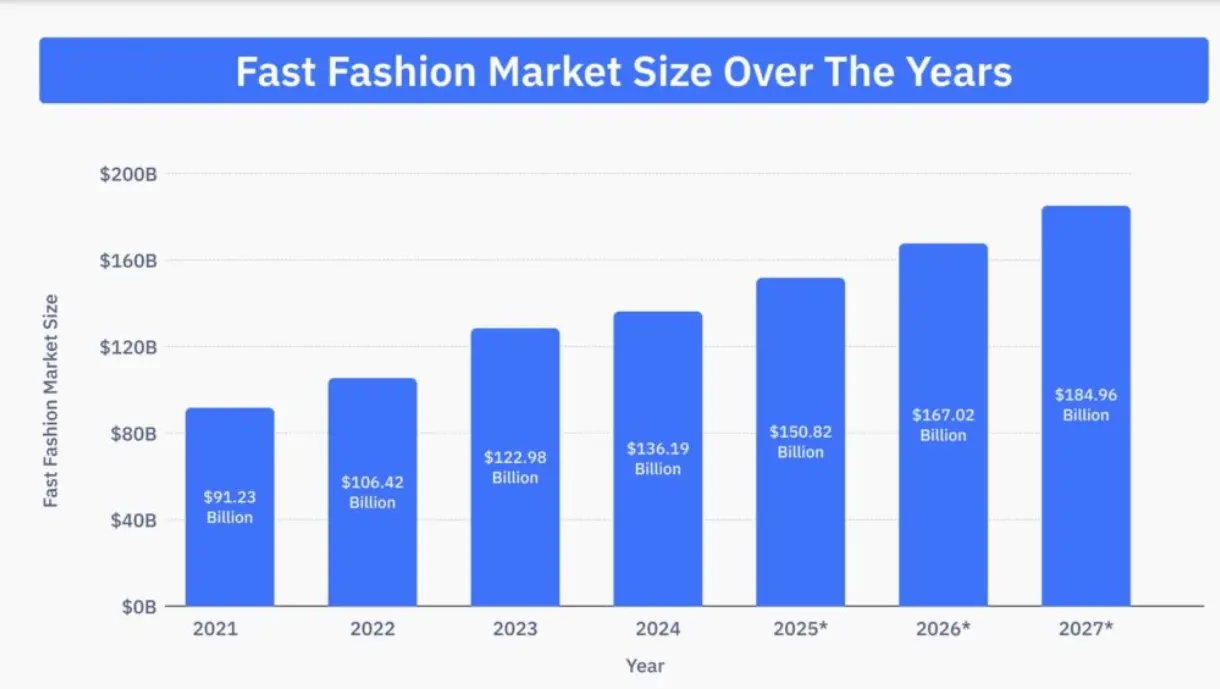
The real cost of this business is becoming clear, from damage to the environment to moral issues.
This blog post will go into detail about how complicated fast fashion is, how it affects many people, and what the future holds for fashion.
Table of Contents
ToggleWhat Is Fast Fashion?

Fast fashion is a way of making clothes in the fashion business that focuses on getting the newest trends from the runway to customers quickly and at a price they can afford.
Traditional fashion cycles happen during certain times of the year. Fast fashion brands, on the other hand, can create, make, and sell new collections in just a few weeks.
Going this fast is possible thanks to mass production, cheap materials, and supply lines that work more efficiently.
Fast fashion takes advantage of people’s need for trendy, up-to-date clothes by letting them buy and throw away clothes at an unheard-of rate.
This method has made fashion easier to get, but it also raises serious questions about quality, sustainability, and how workers should be treated.
Why Fast Fashion Is a Hot Topic?
Fast fashion is a big deal because it is connected to current market trends and social media’s powerful effect on us all.
People today, especially younger people, want the newest styles at prices they can afford. This is what drives the demand for fast fashion.
Instagram and TikTok, where celebrities and influencers always show off new fashion trends, have always made people want something new.
This has led to a society of instant gratification. Fast fashion has become a worldwide phenomenon thanks to social media, where styles can spread very quickly.
Influencers are very important to this ecosystem because they often promote fast fashion brands to millions of fans, speeding up the consumption cycle even more.
This has led to heated debates about whether such fast production is sustainable and the moral implications of a model promoting throwaway fashion.
So, fast fashion isn’t just a trend; it’s a big part of the ongoing conversation about the fashion industry’s future.
Characteristics of Fast Fashion
There are a few main things that set fast fashion apart from more standard fashion models.
One of the most noticeable things about fast fashion is how quickly new styles of clothes can be designed, made, and stocked.
Because they work so quickly, they can quickly cash in on new trends, so customers can get the newest styles almost as soon as they come out on the runway.
Its low cost and big volume production model is another thing that makes it stand out.
Fast fashion businesses can make a lot of clothes at low prices because they use cheap materials and efficient production methods.
This method lowers the cost of fashion, but it often comes at the cost of quality and durability. Finally, fast fashion is based on designs that are based on trends.
These brands make it a priority to copy and follow the latest trends, so customers can always find new and stylish things.
People are constantly told to update their outfits with the newest styles, which leads to a culture of buying things over and over again and throwing them away after a short time.
The Supply Chain of Fast Fashion
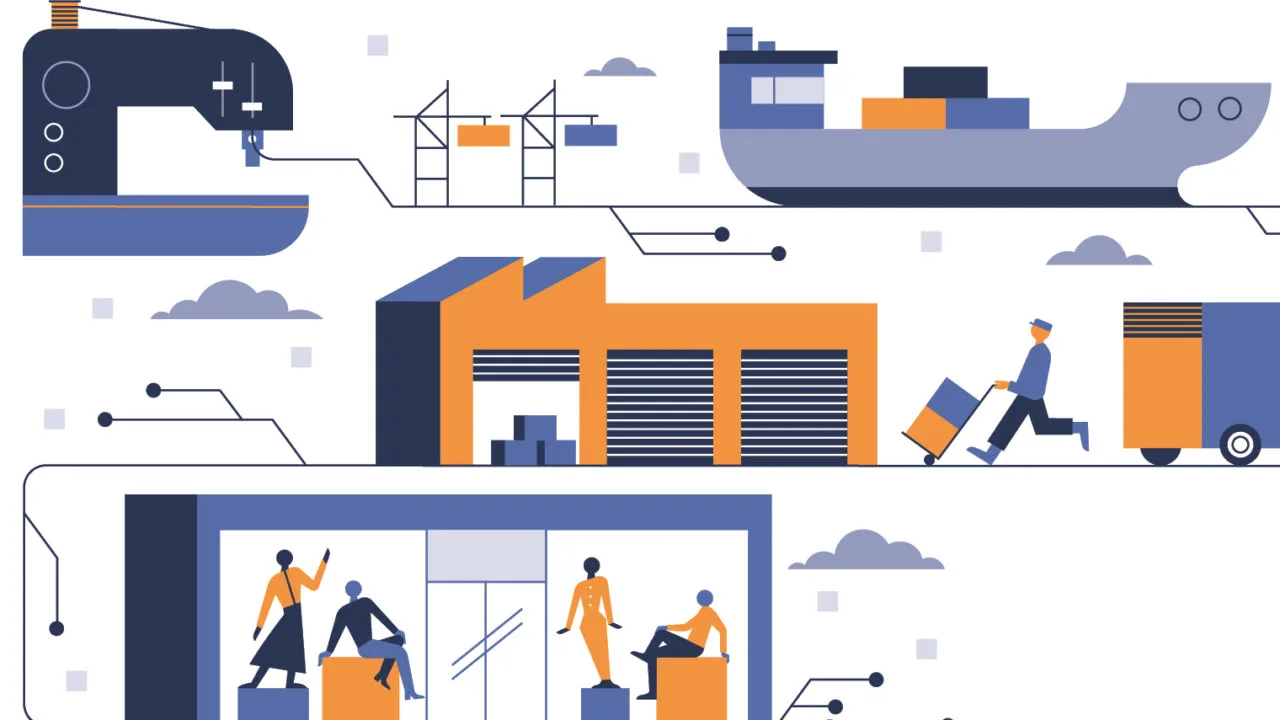
The supply chain for fast fashion is like a well-oiled machine that is made to work quickly, efficiently, and in large quantities.
From the first idea for a design to the clothes being sold in stores, the whole process is very quick, usually only a few weeks.
This level of speed is made possible by a global network of design teams, manufacturers, and logistics providers who work together to cut down on wait times.
Traditional fashion houses may spend months making a collection, but fast fashion brands speed up the whole process, from finding trends to making the final product.
Fast fashion giants like Zara, H&M, and Forever 21 were among the first to use this model. These companies have mastered the art of making things quickly by using huge supply lines that reach across many countries.
Often, they get ingredients from one area, make the products in another, and then ship them all over the world while keeping costs low.
These brands have dominated the market by being able to quickly go from idea to customer, setting the bar for how fast fashion works.
However, this sped-up supply chain makes people worry about working conditions, the environment, and the long-term viability of making so much clothes so quickly.
Comparison with Traditional Fashion
The rise of fast fashion is very different from traditional fashion, especially in how it is made and how it is worn. In traditional fashion, the process of making clothes is often more planned out and takes more time.
For example, designers start working on yearly collections months ahead of time. Most of the time, these collections are made with a focus on quality, using better materials and more complex patterns.
People who like traditional fashion tend to buy less often because they value classic styles that will never go out of style over short-lived trends.
On the other hand, fast fashion brands have changed the business by making production go faster. They don’t follow the usual seasonal calendar; instead, they put out new collections every couple of weeks.
This lets them adjust quickly to new fashion trends. This change has caused people to buy trendy, cheap things more often, which is called a more frequent consumption pattern.
People can get the newest styles at a fraction of the cost of traditional fashion thanks to fast fashion brands like Zara, H&M, and Shein. But this comes at the cost of quality, sustainability, and fair labor practices.
Because of this, traditional fashion is often seen as an investment in long-lasting, high-quality pieces, while fast fashion is known for being disposable and seeing trends come and go quickly.
The Impacts of Fast Fashion
Environmental Impact
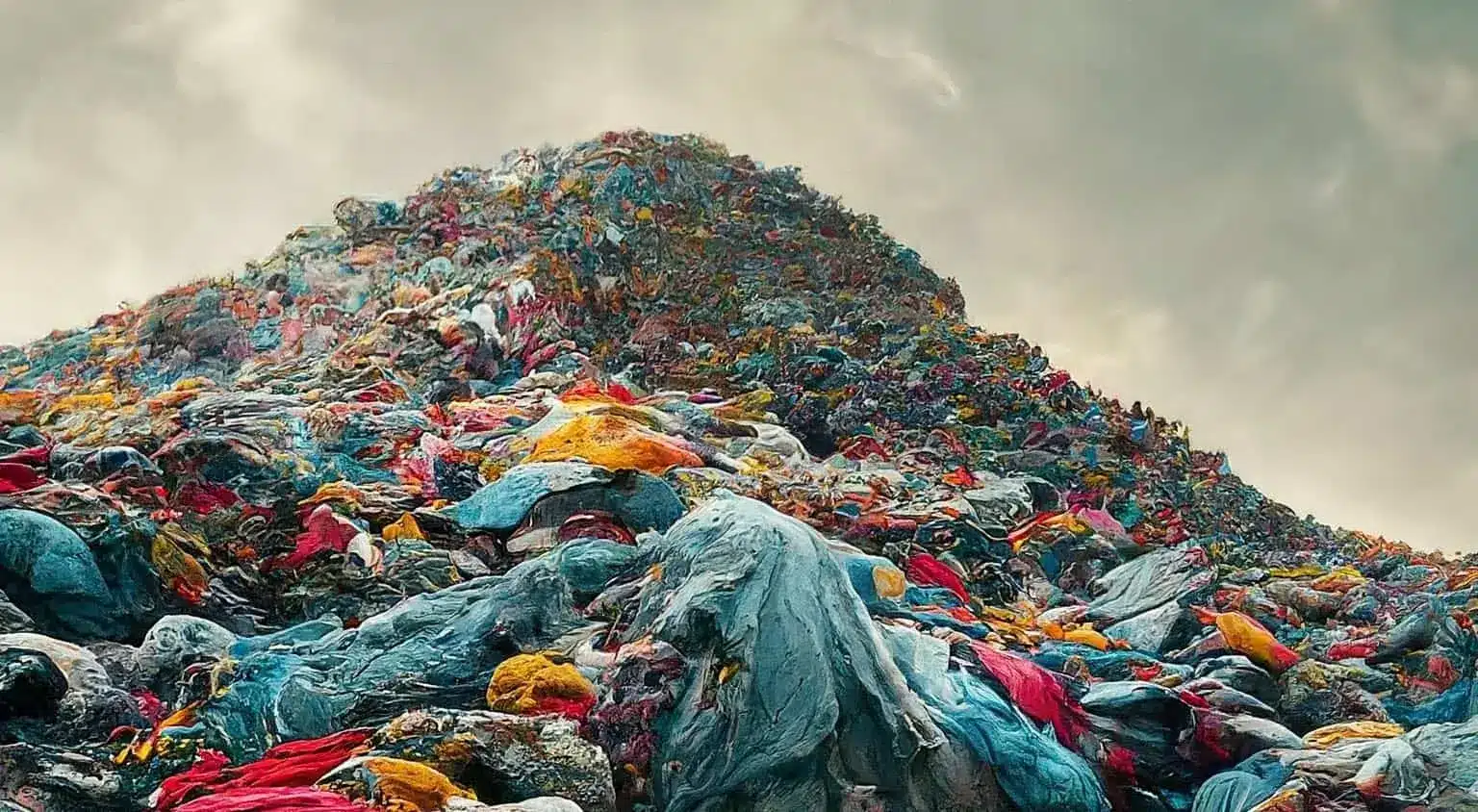
Fast fashion has big effects on the earth, mostly because it uses a lot of resources and makes a lot of pollution.
A lot of natural resources are used by the business, mostly water, energy, and raw materials. Huge amounts of water are needed to make a lot of clothes very quickly.
This is especially true for growing cotton and the dying process. The energy needs of factories also add to the world’s energy use.
Also, getting and handling raw materials, like synthetic fibers made from fossil fuels, uses up more natural resources and leaves a bigger environmental impact on the world.
Another big problem with fast fashion is that it causes pollution. A lot of waste comes from this business because of how quickly things are made.
A lot of this waste ends up in landfills. The problem gets worse when synthetic fabrics are used, since they don’t break down naturally.
Also, the chemicals used to make textiles, like dyes and finishing agents, are often dumped into waterways, where they pollute the water and hurt aquatic environments.
A lot of carbon dioxide is released during the production process, which also contributes to climate change and air pollution.
The problem of cloth waste is one of the most scary effects of fast fashion. The clothing industry’s focus on trendy, low-cost clothes makes people think of clothes as throwaway, which makes them throw them away more often.
A huge amount of textile waste—millions of tons of clothes going to dumps every year—is hard to handle.
A lot of these things that people throw away are made of synthetic fibers, which are bad for the earth because they take hundreds of years to break down.
This cycle of waste shows that fast fashion is not sustainable and stresses the immediate need for more responsible ways to consume and make things.
Social and Ethical Concerns
There are a lot of social and moral problems in the fast fashion business, especially with how workers are treated and the morality of making cheap clothes.
Work practices and abuse are at the heart of these problems. Many fast fashion brands depend on workers from developing countries where wages are low and working conditions are bad in order to keep their prices low.
There aren’t many ways for workers in these factories to improve their situations; they often have to put in long hours for low pay and don’t have much job protection.
The need to make a lot of clothes quickly and cheaply makes these unfair business practices worse and leads to many violations of workers’ rights.
In the fast fashion supply chain, worker rights and safety are also very important.
Many factories are too crowded and don’t have enough safety equipment, which puts workers at risk of accidents and chemical exposure. The terrible events that happened, like the Rana Plaza factory fall in 2013 that killed over 1,000 workers, have shown how bad it is to put profits ahead of worker safety.
Many fast fashion brands still get their clothes from companies with questionable safety standards, even though people all over the world are outraged and calling for change.
This keeps the cycle of danger and disregard for human life going.
Finally, the morality of cheap clothes makes us think deeply about how much fast fashion really costs. People who buy clothes at low prices save money, but the workers who make the clothes and the earth lose out.
The low prices of fast fashion often hide the harsh facts of how it is made, where cheap labor, child labor, forced labor, and bad working conditions are used to keep costs down.
Also, the fact that fast fashion clothes are meant to be thrown away quickly creates a society where clothes are seen as disposable and not valuable.
Not only does this way of thinking make the work less honorable, but it also keeps the circle of exploitation and environmental damage going.
Because of the ethical problems that come with fast fashion, both consumers and companies need to be more aware and responsible.
Economic Impact

The economic impact of fast fashion is profound, influencing everything from global markets to local economies.
Central to the industry’s success is the economics of fast fashion, which revolves around profit maximization through aggressive price wars.
Fast fashion brands achieve their profitability by cutting costs at every stage of production, from sourcing cheap materials to employing low-wage labor in developing countries.
This enables them to offer trendy clothing at rock-bottom prices, creating intense competition among retailers.
The result is a market saturated with low-cost apparel, where price often trumps quality, leading to an unsustainable cycle of overproduction and overconsumption.
While this model drives short-term profits, it also fosters a race to the bottom in terms of wages and working conditions, further exacerbating global inequalities.
The rise of fast fashion has also had a detrimental impact on local businesses and artisans. Traditional fashion producers, small-scale artisans, and local retailers struggle to compete with the low prices and rapid turnover of fast fashion items.
This competition often leads to the decline of local fashion industries, particularly in areas where craftsmanship and quality have historically been valued.
Artisans who rely on traditional methods and higher-quality materials find it increasingly difficult to sustain their businesses in the face of mass-produced, inexpensive alternatives.
The loss of these local enterprises not only affects the livelihoods of those involved but also erodes cultural heritage and diversity in the fashion industry.
Fast fashion’s influence extends far beyond individual markets, playing a significant role in globalization and the fashion economy.
The industry has created a highly interconnected global supply chain, where design, production, and distribution are spread across multiple countries.
This globalization has made fashion more accessible to consumers worldwide but has also concentrated power in the hands of a few multinational corporations.
These companies dominate the market, dictating terms to suppliers and driving down costs, often at the expense of ethical practices and environmental sustainability.
The global reach of fast fashion has also led to the homogenization of fashion trends, with similar styles appearing simultaneously in stores worldwide, reducing the diversity and uniqueness of local fashion scenes.
As fast fashion continues to reshape the global economy, it raises critical questions about the long-term sustainability of this model and its broader impact on society and the environment.
Fast Fashion and Consumer Behavior
Why Consumers Love Fast Fashion
There are several strong reasons why people love fast fashion, but the main ones are that it’s cheap and easy to get.
Fast fashion brands sell trendy clothes at prices that make it easy for people to buy a lot of them without breaking the bank.
This makes fashion more open to everyone and less exclusive by letting people keep up with the latest trends without having to spend a lot of money.
Cutting production and material costs achieves cheap prices. These actions help customers in the short term but raise important issues about quality and sustainability.
The desire for newness and style is another important reason why fast fashion is so popular. New styles and trends are always available because the fashion industry produces clothes so quickly.
This makes the fashion world very active and always changing. People are interested in shopping because it’s fun to find new styles and keep their outfits up to date with the latest trends.
This focus on newness and style appeals to people’s need to always be reinventing themselves and expressing themselves, which leads to a circle of buying a lot of things.
Fast fashion is a great way to stay stylish without having to wait for seasonal collections or buy more expensive pieces that will last for a long time.
This is because fast fashion items are replaced quickly, which fits with a culture that values variety and speed.
Consumer Awareness and Responsibility
In the year 2024, people are becoming more aware of how the clothes they wear affect the earth and society.
People are becoming more aware of the part they play in the fast fashion system as more information about its bad effects, such as the mistreatment of workers and damage to the environment, becomes public.
Because of this, people feel more responsible when they shop, and many of them now think about the moral effects of the things they buy.
Because of this, there is a clear change toward more thoughtful consumption, with people asking more questions about where the clothes they buy come from, how they are made, and what effects they will have in the long run.
One of the most important trends of 2024 is the rise of aware consumerism, which shows a big shift in how people shop.
In the past, fashion trends were mostly determined by how something looked and how much it cost. These days, consumers care more about ideals like social responsibility, sustainability, and ethical sourcing.
This change can be seen in the rising popularity of brands that are open about their actions and dedicated to making good impacts on society and the environment.
People who are conscious don’t just buy things; they actively look for and support businesses that share their values.
They choose quality over number and long-lasting styles over short-lived ones. This movement is not just a fad; it is a strong force that is changing the fashion world.
To choose fashion that is ethical, people need to know about it and be deliberate about how they shop.
One of the first things you should do is look into brands to make sure they follow moral standards like paying workers fairly, making sure they have safe places to work, and using eco-friendly ways to make their products.
People can find companies that are committed to doing business in an ethical way by looking for standards like Fair Trade, GOTS (Global Organic Textile Standard), or B Corp status.
Also, buying clothes made from eco-friendly materials like organic cotton, Tencel, or recycled fabrics can make a big difference in protecting the earth.
Other effective ways to make a difference are to value quality over number, buy used or vintage items, and support local artists.
People who choose these options can help increase the market for ethical fashion and make the future more sustainable.
Fast Fashion in the Age of Sustainability
As people around the world talk more about environment, fast fashion is at a crossroads. Fast fashion’s short production cycles and the urgent need to care for the earth have never been more at odds with each other in 2024.
People are becoming more aware of the damage that throwaway clothing does to the environment, like polluting waterways and causing carbon emissions, and they want more eco-friendly options.
The fashion industry is going through big changes because of this shift. A greater focus on sustainability is testing the old model of fast fashion.
In the past few years, there has been a huge increase in the demand for sustainable fashion alternatives.
People want to buy clothes that are in line with their environmental ideals. This trend can be seen in how popular brands are that use eco-friendly materials, use fair labor practices, and make their supply lines clear.
People are more likely to buy clothes made from organic cotton, reclaimed fabrics, or new materials like mushroom leather and textiles made from algae.
Also, cycle fashion, which includes things like renting clothes, selling them again, and recycling, is becoming more popular.
So, sustainable fashion isn’t just a niche market anymore; it’s a mainstream trend driven by people who want to leave less of an impact on the world.
As consumer pressure grows, many fast fashion brands are being pushed to rethink their ways and change to meet the need for sustainability.
Some brands are putting money into new technologies to cut down on trash and make their production processes more efficient, while others are putting money into “conscious” collections made from eco-friendly materials.
A big focus has also grown on transparency, with more brands giving out details about their supply lines, how they treat workers, and how they affect the environment.
Some businesses are also trying out circular fashion models by providing rental services, take-back programs, and ways to recycle clothes.
Even though these changes are good, fast fashion brands still have to figure out how to balance their short production cycles with the need to be environmentally friendly in the long run.
The Future of Fast Fashion
Challenges Facing the Fast Fashion Industry
As the fast fashion industry looks ahead to 2024 and beyond, it faces a host of significant challenges that threaten to reshape its future.
One of the most pressing issues is the increasing regulatory pressure and new legislation aimed at curbing the environmental and social impacts of fast fashion.
Governments and international bodies are introducing stricter regulations that require brands to adhere to higher standards of sustainability, labor rights, and transparency.
This includes mandates for reducing waste, limiting carbon emissions, and ensuring fair wages and safe working conditions throughout the supply chain.
Failure to comply with these regulations could result in hefty fines, legal action, and reputational damage, forcing fast fashion brands to reconsider their business models.
Regulatory pressure is mounting on the fast fashion industry as policymakers respond to the growing concerns over its environmental and ethical implications.
In 2024, new laws and regulations are being introduced globally, targeting everything from waste management to labor practices.
For example, some countries are implementing extended producer responsibility (EPR) schemes, which hold brands accountable for the entire lifecycle of their products, including end-of-life disposal.
Others are enforcing stricter labor laws to combat exploitation and ensure fair working conditions in garment factories.
These regulations are not only challenging the traditional fast fashion model but are also pushing brands to innovate and adopt more sustainable practices to remain compliant and competitive.
The fast fashion industry is also grappling with supply chain disruptions and the growing imposition of sustainability mandates.
Global supply chains, which are the backbone of fast fashion’s rapid production cycles, have been increasingly vulnerable to disruptions caused by geopolitical tensions, pandemics, and climate-related events.
These disruptions have exposed the fragility of just-in-time manufacturing and highlighted the need for more resilient and sustainable supply chains.
At the same time, sustainability mandates are becoming more stringent, with brands being required to reduce their environmental impact, improve resource efficiency, and adopt circular economy principles.
This includes sourcing sustainable materials, minimizing waste, and implementing recycling programs.
As a result, fast fashion brands are under pressure to overhaul their supply chains to meet these new demands while maintaining their competitive edge.
Innovations in Fashion
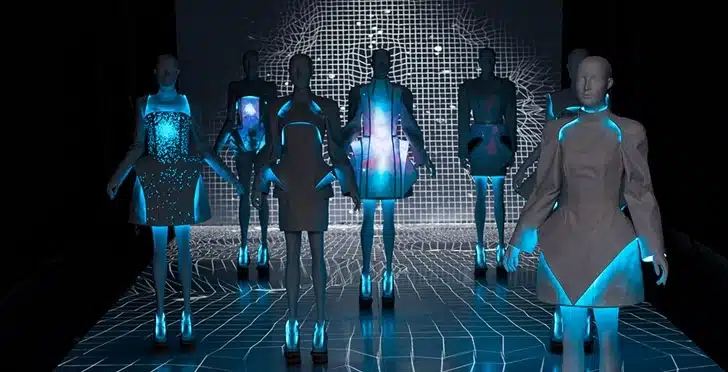
The future of fast fashion is increasingly shaped by innovative approaches that are transforming the industry from within.
Technology is playing a pivotal role in this transformation, revolutionizing how fashion is designed, produced, and consumed.
One of the most significant advancements is the integration of digital technologies like AI, 3D printing, and blockchain.
AI is being used to predict trends and optimize inventory, reducing waste and improving efficiency. 3D printing allows for on-demand production, minimizing excess stock and enabling more personalized designs.
Meanwhile, blockchain technology is enhancing transparency in supply chains, allowing consumers to track the origins and ethical practices behind the garments they purchase.
These technological innovations are not just improving fast fashion brands’ operational efficiency but also pushing the industry toward more sustainable practices.
Technology is at the forefront of the fast fashion industry’s evolution, driving significant changes in production processes.
Advanced manufacturing techniques, such as automated cutting and sewing, are reducing labor costs and increasing production speed, allowing brands to meet consumer demand more efficiently.
Additionally, innovations in material science are leading to the development of sustainable fabrics, such as biodegradable textiles and recycled fibers, which help reduce the environmental impact of fashion production.
Virtual and augmented reality (VR and AR) are also being used to create immersive shopping experiences, enabling consumers to try on clothes virtually and make more informed purchasing decisions.
These technological advancements are not only making fashion production more efficient but are also paving the way for a more sustainable and ethical industry.
As consumers become more aware of the environmental and ethical implications of their fashion choices, there is a noticeable shift toward slow fashion and ethical brands.
Unlike fast fashion, which prioritizes speed and cost over quality, slow fashion focuses on producing high-quality garments that are made to last. This movement encourages consumers to buy less, choose well, and make their clothing investments count.
Ethical brands are gaining popularity for their commitment to fair labor practices, sustainable materials, and transparent supply chains.
These brands often produce smaller, limited-edition collections, emphasizing craftsmanship and longevity over fleeting trends.
As the demand for slow fashion grows, it is likely to challenge the dominance of fast fashion, pushing the industry toward a more sustainable and responsible future.
What Lies Ahead This Year And Beyond
The future of fast fashion is poised for significant transformation. The industry is expected to face ongoing challenges and opportunities as it adapts to evolving consumer expectations, technological advancements, and regulatory pressures.
Fashion retail is predicted to shift increasingly toward sustainability and ethical practices, with brands that fail to adapt likely facing declining sales and reputational damage.
Consumers are expected to continue driving this change, demanding more transparency, higher quality, and a reduced environmental footprint from the brands they support.
The future of fashion retail is likely to be characterized by a blend of digital innovation and sustainable practices.
With the rise of e-commerce and digital platforms, fashion brands are expected to leverage data-driven insights and artificial intelligence to create more personalized shopping experiences.
This will include virtual try-ons, AI-powered trend predictions, and more efficient supply chains that reduce waste.
At the same time, there will be a growing emphasis on sustainability, with more brands adopting circular fashion models, offering clothing rental services, and launching take-back programs to recycle old garments.
As consumers become more eco-conscious, fashion retail will need to align with these values to stay relevant and competitive.
Consumers hold significant power in shaping the future of the fashion industry. By making informed and intentional choices, they can influence brands to prioritize sustainability and ethical practices.
This includes supporting brands that are transparent about their supply chains, opting for high-quality, durable clothing instead of disposable fast fashion, and embracing second-hand shopping or clothing swaps.
Additionally, consumers can use their voices to advocate for change, whether through social media, petitions, or by choosing to support companies that align with their values.
As more people demand accountability and sustainable practices from the fashion industry, their collective actions can drive meaningful change, pushing fast fashion toward a more responsible and sustainable future.
Summary: What Is Fast Fashion
Fast fashion, which gives people a constant supply of new styles at low prices, has become an important part of modern fashion.
Its short production cycles, patterns that follow trends, and large output have changed the way we shop, but at big costs to the environment, society, and the economy.
The problems caused by fast fashion are many and complicated. They range from polluting the environment and using up resources to abusing workers and changing the way traditional fashion is made.
As we move forward, it’s more important than ever to deal with these problems.
Pressure from regulators, new technologies, and a growing need for environmentally friendly alternatives are forcing the business to change.
Slow fashion and responsible brands are becoming more popular, which is a good sign.
However, the future of fashion will depend a lot on how customers and businesses react to these changes.
The fashion business is at a turning point and the fashion choices we make now, as consumers and as business leaders, will affect fashion for many years to come.
By emphasizing ethical practices, responsible consumption, and sustainability, we can guide the fashion industry toward a more balanced and sustainable future.
This will make sure that fashion stays a source of creativity and expression without harming people or the environment.

